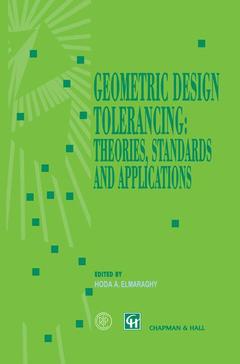Geometric Design Tolerancing: Theories, Standards and Applications, Softcover reprint of the original 1st ed. 1998
Langue : Anglais
Coordonnateur : ElMaraghy Hoda A.

The importance of proper geometric dimensioning and tolerancing as a means of expressing the designer's functional intent and controlling the inevitable geometric and dimensional variations of mechanical parts and assemblies, is becoming well recognized. The research efforts and innovations in the field of tolerancing design, the development of supporting tools, techniques and algorithms, and the significant advances in computing software and hardware all have contributed to its recognition as a viable area of serious scholarly contributions. The field of tolerancing design is successfully making the transition to maturity where deeper insights and sound theories are being developed to offer explanations, and reliable implementations are introduced to provide solutions. Machine designers realized very early that manufacturing processes do not produce the nominal dimensions of designed parts. The notion of associating a lower and an upper limit, referred to as tolerances, with each dimen sion was introduced. Tolerances were specified to ensure the proper function of mating features. Fits of mating features included clearances, location fits, and interference fits, with various sub-grades in each category assigned a tolerance value depending on the nominal size of the mating features. During the inspection process, a part is rejected if a dimension fell outside the specified range. As the accuracy requirements in assemblies became tighter, designers had to consider other critical dimensions and allocate tolerances to them in order to ensure the assembly's functionality.
Modeling Representation and Processing of Tolerances,Tolerance Inspection: A Survey of Current Hypothesis.- I Tolerance Theory and Standards.- 1 International Standards for Design Tolerancing Review and Future Perspective.- 2 Research In Statistical Tolerancing: Examples of Intrinsic Non-Normalities and their effects.- 3 Composing Distribution Function Zones for Statistical Tolerance Analysis.- 4 ISO Deliberates Statistical Tolerancing.- 5 Relations Between ISO 1101 and Geometric Tolerances and Vectorial Tolerances - Conversion Problems.- 6 The Tools & Rules for Computer Automated Datum Reference Frame Construction.- II Tolerance Representation in CAD.- 7 Remarks on the Essential Element of Tolerancing Schemes - Short Communication.- 8 The TTRS: 13 Constraints for Dimensioning and Tolerancing.- 9 Variational Method for Assessment of Toleranced Features.- 10 The Application of FAST Diagrams to Dimensioning and Tolerancing.- 11 Identifying and Quantifying Functional Element Dispersions During Functional Analysis.- 12 Three Dimensional Functional Tolerancing with Proportioned Assemblies Clearance Volume (U.P.E.L.: Unions Pondérées d’Espaces de Liberté): application to setup planning.- III Modeling of Geometric Errors.- 13 Determination of Part Position Uncertainty Within Mechanical Assembly Using Screw Parameters.- 14 A Computation Method for the Consequences of Geometric Errors in Mechanisms.- 15 A Unified Model for Variation Simulation of Sheet Metal Assemblies.- 16 Practical Applications for Intersections of Mechanical Primitives for Geometric Tolerancing.- 17 Functional Dimensioning and Tolerancing of Manufactured Parts for Fluid Leakage Control.- 18 Geometric Tolerancing for Assembly with Maximum Material Parts.- 19 More on the Effects of Non-Normal Statistics in Geometric Tolerancing - Short Communication.- IV Tolerance Analysis and Synthesis.- 20 A New Algorithm for Combinatorial Optimization: Application to Tolerance Synthesis with Optimum Process Selection.- 21 Automated Cost Modeling for Tolerance Synthesis Using Manufacturing Process Data, Knowledge Reasoning and Optimization.- 22 A Comprehensive System for Computer Aided Tolerance Analysis of 2-D and 3-D Mechanical Assemblies.- 23 Parametric Kinematic Tolerance Analysis of Planar Pairs with Multiple Contracts.- 24 Advanced Methodology and Software for Tolerancing and Stochastic Optimization.- 25 Towards a Designed Experiments Approach to Tolerance Design.- V Evaluation of Geometric Deviations.- 26 An Iterative Approach to Profile Evaluation Using Interpolation of Measured Positions and Surface Normals.- 27 Virtual Gage with Internal Mobilities for the Verification of Functional Specifications.- 28 On the Accurate Evaluation of Geometric Deviations from CMM Data.- 29 Tolerancing of Free Form Surfaces.- 30 Minimum Zone Evaluation of Cylindricity Using Non-Linear Optimization Method.- VI Industrial Applications and CAT Systems.- 31 Geometrical Evaluation Models in Sheet Metal Forming: A Classification Method for Shape Errors of Free-Form Surfaces.- 32 Tolerancing Problems for Aircraft Industries.- 33 Teaching Tolerances: A Comparison Between The Conventional and Reverse Engineering Approaches.- 34 Current Status of CAT Systems.- 35 Tolerance Analysis Using VSA-3D for Engine Applications.- Authors’ index.- Keyword index.
This book addresses Mechanical Engineering Tolerance related research areas and implementation with a special focus on design issues. It features keynote papers on modelling, representation and inspection of tolerances as well as reviews of relevant evolving international standards and future directions. Contributions deal with topics such as tolerance analysis, modelling, synthesis and evaluation of geometric deviations in addition to addressing industrial applications and CAD software implementations.
Date de parution : 10-2012
Ouvrage de 468 p.
15.5x23.5 cm
Thème de Geometric Design Tolerancing: Theories, Standards and... :
Mots-clés :
Normal; Reverse Engineering; control; manufacturing; mechanical engineering; mechanism; metal; optimization; simulation; software; uncertainty
© 2024 LAVOISIER S.A.S.
